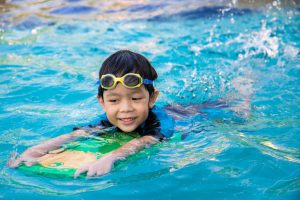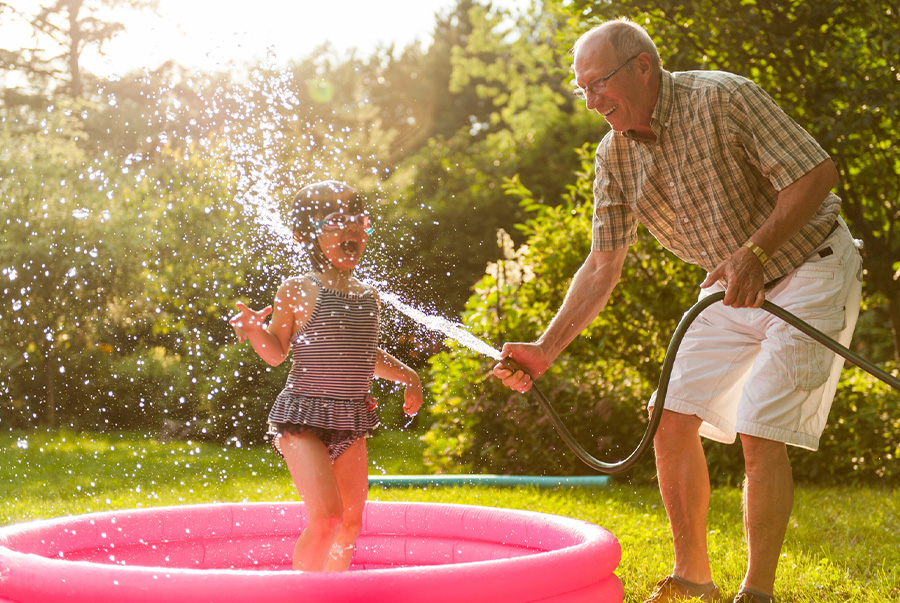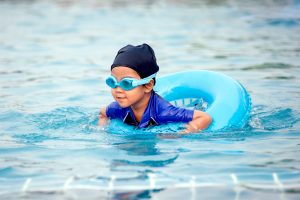Benefits of Water Play for Children
Splish, splash! Water play time!
Summer is the perfect time to explore, and there’s nothing more fun than spending time in water.
No matter if it’s in the ocean, lake, creek, community pool, or tub in the backyard, playing in the water may help children grow and develop in these essential ways:
Balance and Strength
 Though it might look like your child is just splashing around, water play can help improve children’s balance and strength. Playing in water is like playing in a brand new playground where even the simplest activities, like clapping your hands or jumping, are a whole new sensory experience. Children can experiment without worrying about falling or crashing into hard surfaces. Water also adds resistance so water play activities work as strength training. It takes more muscle strength to move arms and legs through water then it does through air.
Though it might look like your child is just splashing around, water play can help improve children’s balance and strength. Playing in water is like playing in a brand new playground where even the simplest activities, like clapping your hands or jumping, are a whole new sensory experience. Children can experiment without worrying about falling or crashing into hard surfaces. Water also adds resistance so water play activities work as strength training. It takes more muscle strength to move arms and legs through water then it does through air.
 Coordination
Coordination
Swimming develops muscles and motor skills and helps improve coordination. Kicking movements engage the core, and can help children learn how to coordinate both sides of their body to move through the water. When children swim, dance, throw objects, or practice any movement in water they’re developing coordination.

Communication and Social Skills
Water play allows children to explore and interact with each other. New experiences and discovering new things within shared spaces offer a great opportunity for social development. As children play, they will be excited to communicate their discoveries to everyone around them. This is a confidence booster for kids! Because water play typically occurs in a limited space with few supplies, children practice sharing with each other and working together while engaging in play. There are many opportunities for communication development and social growth during water play!
Exploration and Learning
Bodies of water offer endless opportunity for physical experiments and discoveries. Children may have already investigated wood, dirt, sand, rocks, and other dry substances. But what happens when these substances are mixed, sifted, or dropped with water? Children also get the opportunity to think about concepts like water displacement and volume as they explore in a body of water. Water supports a variety of life forms like fish and frogs, so water play can lead to new biological adventures as well!
 Water play can be a fun summer activity and also allow children the opportunity to practice many valuable skills. But it is important to remember to never let children play in or nearby water unsupervised. Don’t allow children to play with non-CPSC approved toys, and do not trust flotation devices solely to support a child who cannot swim on his or her own.
Water play can be a fun summer activity and also allow children the opportunity to practice many valuable skills. But it is important to remember to never let children play in or nearby water unsupervised. Don’t allow children to play with non-CPSC approved toys, and do not trust flotation devices solely to support a child who cannot swim on his or her own.
Safety Tips
- Don’t leave your child unattended, even for a second, near water – including bathtubs!
- Have all caregivers become trained in CPR in case of an emergency.
- If you have a pool cover, ensure it is completely removed before swimming and do not allow your child to walk or crawl on it.
- Enforce rules around the pool. Children should not run near the pool or push others underwater.
- Make it clear that some activities, like bike riding, should not be done near the water.
- Flotation devices are not a substitute for supervision. Always stay within an arm’s length from baby.
- Life jackets should always be worn when riding on a boat.
- The AAP says children are not typically ready for formal swim lessons before their first birthday. But remember: swimming lessons are meant to increase a child’s comfort level in the water but do not replace caregiver supervision!
Check out what else to expect from your baby. Follow their milestones here!